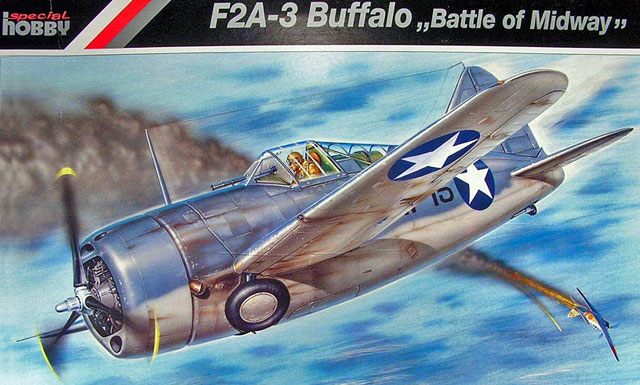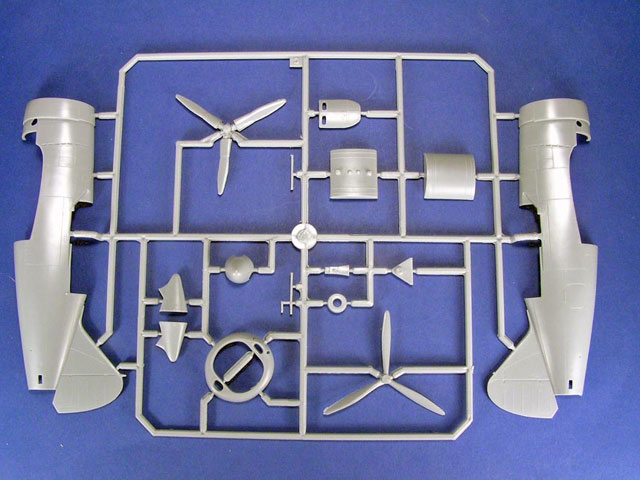|
Brewster
F2A-3 Buffalo
"Battle of Midway"

Special
Hobby, 1/48
S u m m a r y
|
|
Catalogue Number: |
SH48032
- Brewster F2A-3 Buffalo "Battle of Midway" |
|
Scale: |
1/48 |
|
Contents and Media: |
82 parts in grey styrene, 4 parts in clear
injection molded for canopy, 4 parts in
cream colored resin 36 etched metal piece
and printed film for the instrument panel.
Instructions and decal sheet for four
aircraft. |
|
Price: |
USD$39.96 on line from Squadron.com |
|
Review Type: |
FirstLook - In Box |
|
Advantages: |
Highly detailed with finely engraved panel
lines and surface features. |
|
Disadvantages: |
Poorly packed clear parts resulting in
scratching and separation from the sprue. |
|
Recommendation: |
Highly
Recommended |
Reviewed by
Steven "Modeldad" Eisenman

Special Hobby's 1/48 scale F2A-3 Buffalo
is available
online from Squadron
Fed-up with Brewster and the
shortcomings of the Buffalo, the U.S. Navy put in it
final order for the F2A Buffalo in January 1941. This
was to be the “improved” –3 model. The F2A-3 had a
lengthened fuselage, increased fuel and ammunition
capacity and increased armor. As one author put it,
“The result was…the sports car transformed into a
slug”.*
The –3 was assigned to VF-2, VF-3
and VS-201. VF-3 flew the –3 Buffalo for only a short
period of time, replacing them with F4F-3 Wildcats.
With VS-201 on the USS Long Island, the –3 Buffalo was
relegated to neutrality patrols in the Atlantic, and was
kept on after war with Germany was declared in
anti-submarine patrols until April 1942.
At the time of the Attack on Pearl
Harbor, the only Navy squadron in the Pacific to operate
the –3 Buffalo was VF-2 aboard the USS Lexington. The –3
scored not one kill with VF-2 and was again replaced by
the F4F-3 Wildcat. It seems that the Navy was quite
happy to rid itself of the –3 Buffalo, as it suffered
from landing gear failures, due to its increased weight.
It appears that “[t]he Navy solved the F2A-3 problems
the way it often solved problems with unsatisfactory
equipment: by giving it to the Marines.”*
Two Marine units received the cast
off –3 Buffalos, VMF-211 on Palmyra Island, which was
south of Hawaii and VMF-221 on Midway Island, west of
Hawaii. It was with VMF-221 that the Buffalo scored its
first American wartime victory. But it was during the
Battle of Midway that the Buffalo earned its reputation
as an inadequate fighter aircraft or a poorly utilized
fighter. The debate continues to this day.
This Buffalo is no carbon copy of
the old Tamiya kit. First, it is a –3, with the
lengthened fuselage. Second, there is extensive interior
detail, especially in the wheel bay area. Finally, the
surface detail is far superior. Gone are access panels
that stand proud of the surface, as are the over done
fabric control surfaces.
The forward part of the fuselage
has the framing and guns for the gun bay. There is a
fuel tank that sits in the location under the cockpit
floor and above the old observation window, which has
been removed. There is also engine support framing and
the rear of the engine is done in a finely cast piece of
resin.

Click the thumbnails below
to view larger images:
The finely engraved plastic is free
of flash. The sprue gates are some of the least
intrusive I have seen in a limited run kit. Even so,
care must be given to removing parts from the sprue. You
will also need to remove a few injection stubs,
especially on the inside of the wing components. As
with most limited run kits, there are no locating pins
to help align the parts.
Similar to a Hasegawa kit, the
Special Hobby –3 Buffalo includes parts for the earlier
versions of the F2A. The instructions indicate which
parts are not to be used with an “X”.
There is an extensive set of etched
metal, which includes break lines for the landing gear
and bomb racks. There are two small bombs in injection
molded plastic, but the fins are in etched metal.
The clear parts are quite clear and
the framing is quite well done, which is an aid in
masking. There are clear parts for all variations of
the F2A. The canopy for the –3 is noticeably different,
as it should be, in that the heavy framing on the
sliding portion was replaced with butt joined and sealed
Plexiglas pieces. The Squadron/Signal In Action on the
Buffalo indicates that there was a small emergency
ration hatch on the bottom portion of the first frame on
the left side of the rear portion of the canopy. This
is not molded on the kit canopy. I presume this could
be represented by simply not masking that part of the
canopy when painting.
The biggest problem with the clear
parts is that they are in with all the other pieces,
unprotected. Given that the clear parts are much less
flexible than the other plastic in the kit, many snapped
off the sprue and some were scratched. As the decals
and etched metal were packed in separate plastic bags,
so should the clear parts.
Markings:
The Special Hobby –3 Buffalo comes
with well printed, by AVIPRINT, and in-register decals
for four aircraft. All aircraft are depicted in USN
Blue-Gray over Light Gray.
The colors are referenced for Gunze
paints.
-
VF-2, USS Lexington, Novermber 1941. Coded 2-F-18,
flown by Howard S. Packard. This aircraft carried
the smaller national marking with a red center.
-
VMF-221, MCAS Ewa, Hawaii, April 1942. This
aircraft is coded 2-MF-13 and carried the larger
national marking with a red center and has the red
and white striped rudder, for which a decal is
provided.
-
VMF-221, Midway, June 1942. This aircraft is coded
MF-15 and was flown by Capt. William C. Humberd.
This aircraft carries the national markings without
a red center and without a striped rudder.
-
VMF-221, Midway, March 1942. This aircraft is coded
MF-11. But to make up the code you will need to cut
off the “5” from the VF-15 marking and replace it
with the additional numeral “1”.
Click
the thumbnails below to view larger images:
There is no question that this model
will literally fly off the shelves with regard to those
modelers who want to do a Battle of Midway theme
collection. Granted the Blue-Gray over Light Grey
scheme may be a bit monochromatic, but with this release
of the –3 Buffalo and the imminent release of the
Accurate Miniatures Vindicator, it should be add to a
most interesting collection.
I’m sure there are many modelers
who will say that the Tamiya kit is fine at nearly half
the price. This is true, if you only want to make a –2,
or don’t care if you scratch build the changes for a
–3. But given the level of detail of this kit, and its
price in relation to other current kits (which are not
nearly 20 years old), this looks to be one very fine
kit.
Just looking at the parts on the
sprues, this looks like a kit that would be fine for a
modeler less experienced in limited run kits. On the
other hand, those etched metal parts could be quite
daunting, as many need to be bent into shape and some
could be super-glued to one’s forehead just as easily as
to the cockpit. With care, I believe this will build
into a fine looking model.
Highly Recommended
References:
-
F2A Buffalo in action; by
Jim Maas; Squadron/Signal; 1987.
-
The Sorry Saga of The
Brewster Buffalo; by Daniel Ford, Air & Space,
June/July 1996.*
Thanks to MPM / Special Hobby for the
review sample.
MPM
kits are available worldwide through hobby retailers
worldwide
and at
Squadron.com
Review and Images Copyright © 2005 by
Steven
Eisenman
Page Created 03 June, 2005
Last updated
28 June, 2005
Back to
HyperScale Main Page
Back to
Reviews Page |
Home | What's
New | Features
| Gallery |
Reviews | Reference
| Forum
| Search